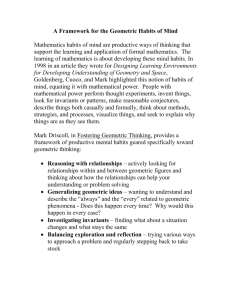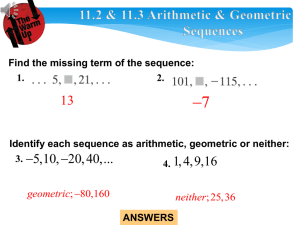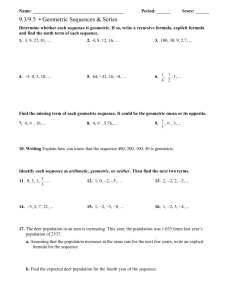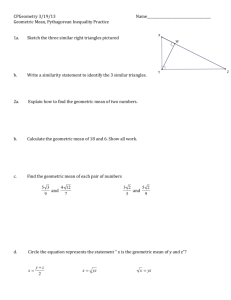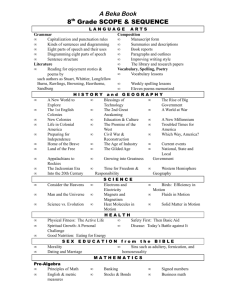Beauty of Geometry PP - Mathematical Sciences :: CCSU
advertisement
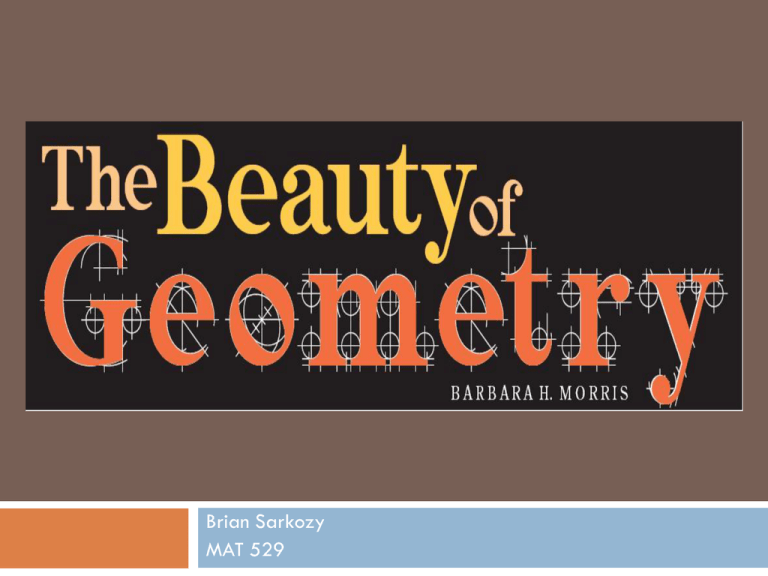
Brian Sarkozy MAT 529 Brief Overview Purpose Students should understand and apply twenty essential geometric terms Students should use application, analysis, synthesis and evaluation processes Students should make connections to the real world Focus Geometric shapes and spatial understanding activity Communication among students for analysis and evaluation of each other Audience 7th grade honors pre-algebra students from three middle schools Parents, students, teachers and community members on “Expo Night” Standards NCTM Standards Analyze characteristics and properties of two-dimensional geometric shapes and develop mathematical arguments about geometric relationships Understand relationships among angles, side lengths, perimeters, areas, and volumes of similar objects Use visualization, spatial reasoning, and geometric modeling to solve problems Draw geometric objects with specified properties, such as side lengths or angle measures Use visual tools such as networks to represent and solve problems Recognize and apply geometric ideas and relationships in areas outside the mathematics classroom, such as art, science, and everyday life Communicate their mathematical thinking coherently and clearly to peers, teachers, and others Analyze and evaluate the mathematical thinking and strategies of others Recognize and apply mathematics in contexts outside of mathematics Standards Connecticut Standards Classify and describe polygons and solids using defining characteristics (MA8:6b, c) Draw geometric objects with specified properties, including angle measure (MA8:6b) Examine the congruence, similarity, and line and rotational symmetry of objects (MA8:6d) Investigate the relationship among the angles, side lengths, perimeter and areas and volumes of similar objects (MA8:6d) Key Points of Activity First Requirement Study stained-glass designs from ancient history to present day Use online resources, library materials, and videotapes on artists Discover geometric configurations in cards and stationary, buildings, artwork, furniture and wallpaper Second Requirement Write a definition, find an example, draw an illustration, and determine an application for each of the essential geometric terms The students were required to incorporate twenty terms, which were given to them Various methods and formats were used when students created their glossary of terms Key Points of Activity Examples of Stained-Glass Key Points of Activity Third Requirement Each student created their own original stained-glass-window designs that incorporated the twenty geometric figures They drew blackline patterns on computer paper and made two copies This was their template, which they put under the glass of an 8inx10in picture frame, painting the glass based on their pattern Fourth Requirement Each student assessed another student’s work. Each student used the given symbols to analyze, mark, and label the twenty required figures of one of their classmates blackline design, then wrote an evaluation of how the design met the requirements The teacher evaluated each student’s work, as well as their assessments of each other Key Points of Activity Implementing Activity in the Classroom With prior knowledge of geometric shapes and similarities and differences with them, students would be able to fully participate in the activity To make it less time consuming, the first requirement does not have to be used Over two days or three days, the students should be able to complete the other three requirements of the project Instead of using paint and glass from picture frames in order to save on cost, students can use construction paper and markers or colored pencils Additional information could be found for each object For each shape used within the twenty objects, students could be required to find lengths of sides, perimeters and areas Each student could use their own numbers, making each project even more unique Other shapes can also be used, such as parallelograms and rhombuses Is This Activity Useful? Would the students gain the requirements of the given standards while participating in this activity? Would this activity be something high school students would be motivated to want to do? Would they find it interesting enough to stay engaged? What are some other ways this activity could be changed in order to make it more meaningful or more engaging for high school aged students? Bibliography Morris, Barbara H. The Beauty of Geometry. Mathematics Teaching in the School, Vol. 9, No. 7, March 2004. Middle

